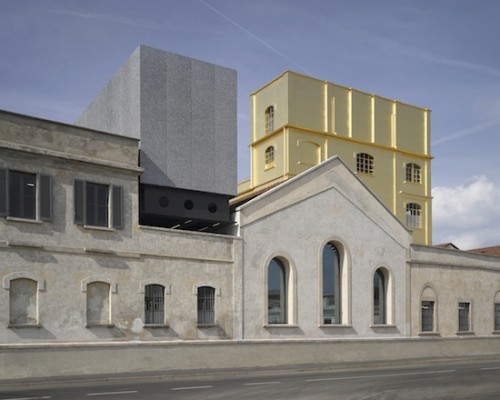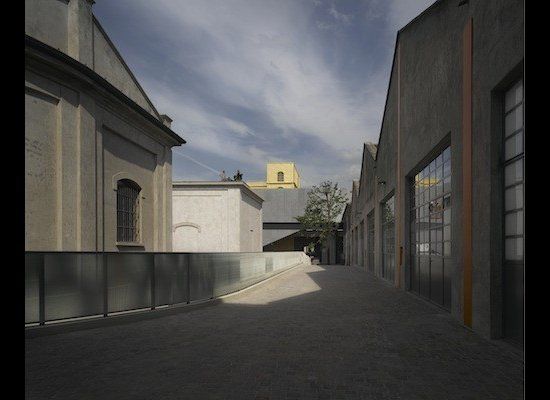The commission to design a contemporary art museum is one of the most prestigious an architect can receive. The confluence of creativity with money allows a firm to both experiment, and realize its dreams. Below, we've listed the top five most exciting contemporary art museums that you should visit in 2015.
By Brienne Walsh, August 4, 2015
1. Fondation Louis Vuitton
Architect: Frank Gehry
Location: Paris
Opening Date: October 2014
Rising like a tumbled mass of sails from the green expanse of the Bois de Boulogne park in Paris, the Fondation Louis Vuitton, designed by Frank Gehry, has already become a landmark in the city of light. Begun with a conversation between Gehry and Bernard Arnault, the chairman and CEO of LVMH Moët Hennessy-Louis Vuitton, in 2001, the structure was inspired by the glass palaces of the 19th century -- including the Palmarium, a glass and steel structure that once housed exotic plants and birds, and was once located in the Bois de Boulogne itself. Characteristic of much of Gehry's earlier work including the Guggenheim Bilbao and the Disney Concert Hall in Los Angeles, the Fondation Louis Vuitton, from the exterior, looks weightless and otherworldly, as if it could not possible be a permanent form. Underneath this outer shell lies an irregular volume of 11 galleries known as the Iceberg. Created from walls of fiber-reinforced concrete, the galleries provide a regular and well-lit space to hang highlights from the LVMH permanent collection, which includes works by Ellsworth Kelly, Olafur Eliasson, Janet Cardiff, Otto Diz, Matisse, Tacita Dean and Adrián Villar Rojas, among many other artists.
The collection was unveiled in three different phases. This summer, the final was revealed. It focuses on pop culture and music as translated in works by Jean-Michel Basquiat, Andy Warhol, Gilbert & George, Marina Abramovic, John Cage and Richard Prince, among others.
2. Fondazione Prada
Architect: Rem Koolhaas and his firm OMA
Location: Milan
Opening Date: May 9, 2015
For over twenty years, the Fondazione Prada, which is co-chaired by Miuccia Prada and her husband Patrizio Bertelli, staged contemporary art and architecture exhibitions in abandoned warehouses and temporary exhibition spaces throughout Europe. With its new permanent home, which is located in a former distillery in Largo Isarco, an industrial neighborhood in Milan and encompasses 120,000 square feet of exhibition space, it will likely become a major destination for contemporary art lovers throughout the world. Almost double the size of the new Whitney Museum in New York, the campus of buildings, which includes three new structures designed by Dutch architect Rem Koolhaas and his firm OMA, as well as seven older buildings that they also renovated, looks, at first glance, like a surreal landscape first painted by Giorgio de Chirico. Above a row of muted gray facades rises a gleaming tower clad in 24-karat gold. Known as the "haunted house," it holds a permanent installation by American sculptor Robert Gober, as well as two works by Louise Bourgeois. Unexpected -- and gorgeous -- facades abound throughout the complex, which bring texture to what otherwise might be a bleak landscape. A new cinema building, sunken into the ground, is clad entirely in mirrored stainless steel, adding a touch of reflective silver to the landscape. Other materials include glass, white concrete and an aluminum that has been treated to look like speckled marble.
Through the summer, the Fondazione Prada will show "Serial Classic," an exhibition that focuses on copies of classic Greek statuary made by ancient Romans -- a topic that seems dated, but very much relates to the current production of art today, which constantly reuses and recycles past work to create contemporary commentary.
3. Whitney Museum
Architect: Renzo Piano
Location: New York
Opening Date: May 1, 2015
Located at the starting point of the High Line, on Gansevoort Street in the Meatpacking District, the new building for the Whitney, designed by Italian-architect Renzo Piano, is a gleaming, stacked mass of glass and metal that looks out over the Hudson River. Replacing the Whitney's former home on the Upper East Side, in an iconic building designed by Marcel Breuer, the new structure responds to the institution's need for larger galleries to show more ambitious exhibitions, as well as its unmatched -- and ever expanding -- permanent collection of 20th and 21st century art. With a cantilevered entrance that serves as a public space not only for visitors of the museum, but also for the heavy foot traffic that traverses the neighborhood, the building expands beyond the cloistered 50,000 square feet of indoor galleries, and out into the city. The sense that it is part of the action as opposed to a fortress from it is heightened by 13,000 square feet of outdoor exhibition spaces and terraces, which are connected by exterior staircases.
The inaugural exhibition, "America is Hard to See," is open through September 27, 2015.
4. The Broad
Architect: Diller Scofidio + Renfro
Location: Los Angeles
Opening Date: September 20, 2015
Built by the philanthropists Eli and Edythe Broad to house over 2,000 works of art in The Broad Art Foundation, as well as from their personal collection, The Broad will be a 120,000-square-foot museum and lending library located in downtown Los Angeles next to Frank Gehry's Walt Disney Concert Hall. Designed by Diller Scofidio + Renfro, the structure has been dubbed "the veil and the vault" because it merges two key functions of the institution -- exhibiting and archiving -- into one singular structure. The vault, which will support The Broad Art Foundation's extensive lending activities to other museums and institutions around the world, will form a central opaque mass that will serve as the nucleus of the space -- it's sides will shape the lobby, as well as the public circulation routes and its top surface will serve as the floor of the third floor galleries. The veil, a porous, honey-comb-like surface will shape the air above it, bringing natural light and a sense of cathedral-like grandeur to the 23-foot-high galleries. The block-long building will be abutted to the south by a 24,000-square-foot public plaza, also designed by Diller Scofidio + Renfro, that will include 100-year-old Barouni olive trees and an open lawn. Much like the Whitney's public plaza in New York, it will service to open the museum up to foot traffic, and connect the museum to other cultural institutions in the area, such as the Museum of Contemporary Art located directly across the street.
5. Arquipelago Contemporary Arts Center
Architects: Menos é Mais Arquitectos and João Mendes Ribeiro Arquitecto
Location: Ribeira Grande, Portugal
Opening Date: February 2015
Also housed in a former tobacco and alcohol factory, the Arquipelago Contemporary Arts Center is located on São Miguel, the largest of the islands in the Azores archipelago. The new site, designed by two Portuguese firms -- Menos é Mais Arquitectos and João Mendes Ribeiro Arquitecto -- consists of a confluence of the new and the old. Along with refurbishing the existing building, the architects also built a center for arts and culture, storage facilities, a multipurpose hall for performing arts and artist studios. Together, the buildings look like a sculptural installation by a minimalist such as Donald Judd or Richard Serra. The stones of the older structures meet at angles with new cantilevered concrete courtyards marked by vanishing lines; the interiors are lit by windows that run along the base of the floor, casting galleries in sculptural, unique light. Arquipelago Contemporary Arts Center aims to service culture in general, with a focus on contemporary art and performance. In the coming years, the institution plans on establishing its own collection of 21st century art. In the meantime, the building was shortlisted for a 2015 Mies Van Der Rohe Award, one of the most prestigious awards in the architecture world.
Brienne Walsh is an ARTPHAIRE contributor, as well as a freelance writer who contributes to Art in America, Interview Magazine, The Huffington Post, Glo, NY Mag, The New York Times and the NY Daily News, among other publications.

